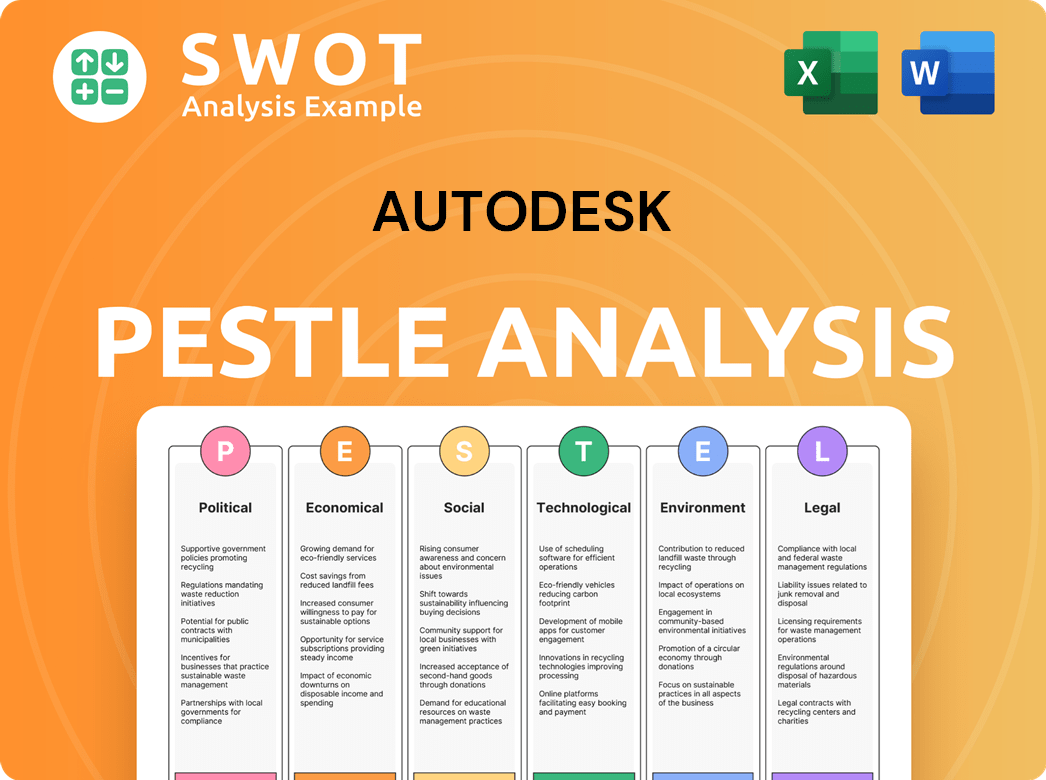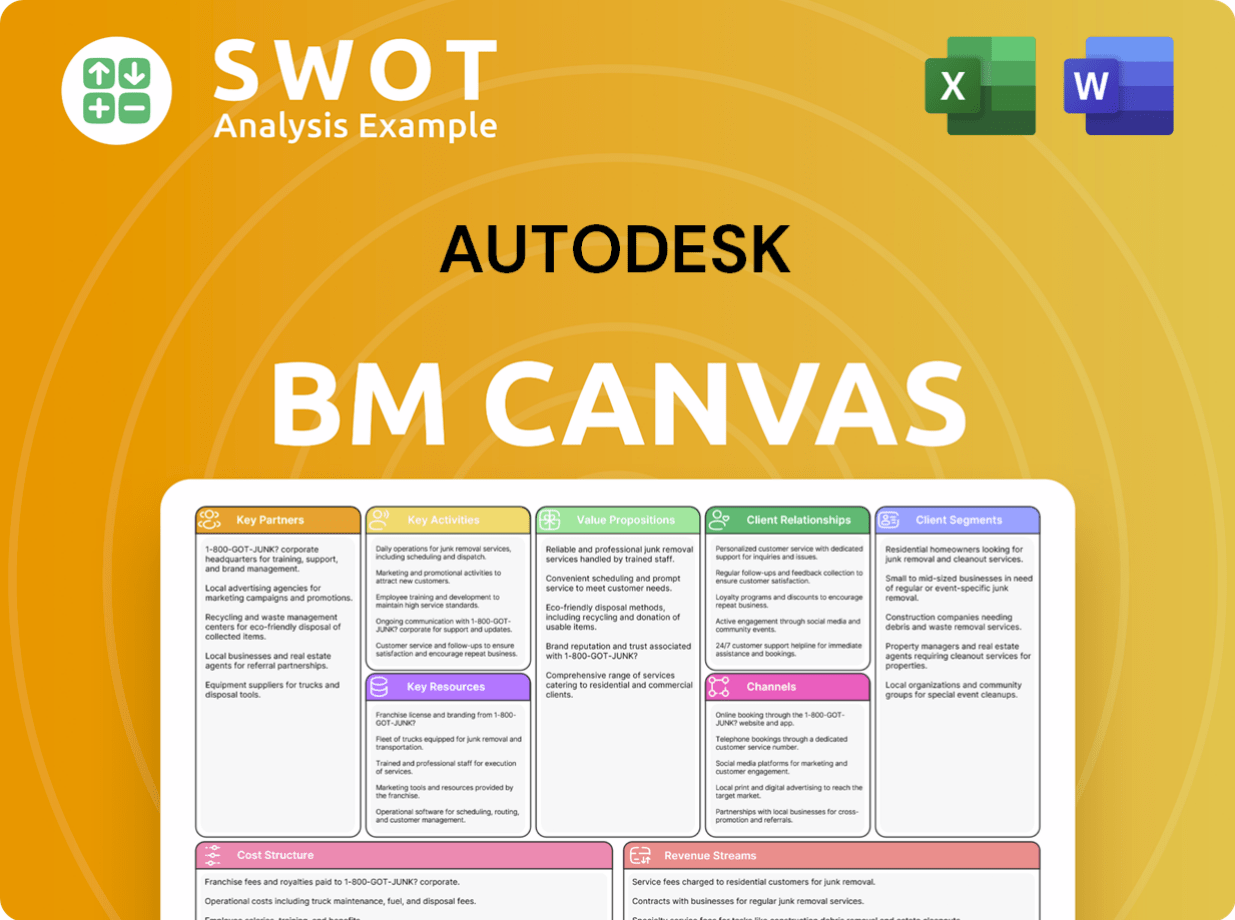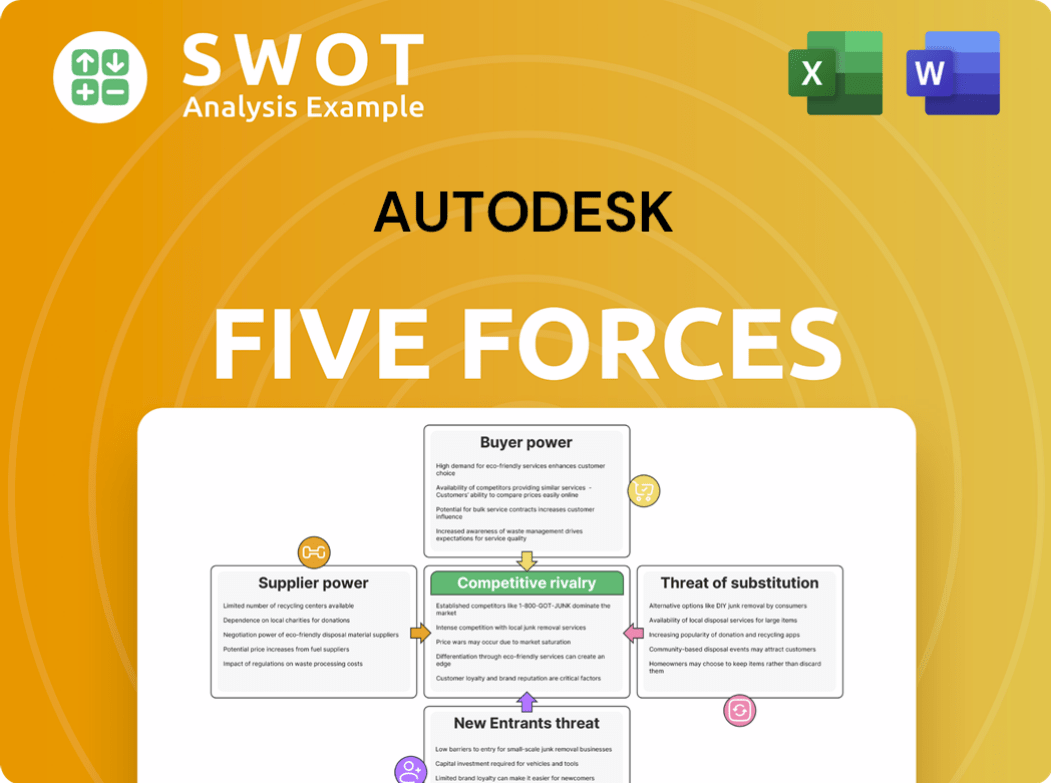Autodesk Bundle
How Has Autodesk Revolutionized its Sales and Marketing?
Autodesk's transformation from perpetual licenses to a subscription-based model redefined its Autodesk SWOT Analysis, fundamentally altering its sales and marketing strategy. This strategic shift, solidified around 2016, propelled the company into a new era of recurring revenue and cloud-based services. This evolution required a complete overhaul of how Autodesk reaches and engages its diverse customer base across key industries like architecture, engineering, and manufacturing.

This exploration delves into the core of Autodesk's contemporary Autodesk sales strategy, dissecting its sophisticated Autodesk marketing strategy and its impact on the Autodesk business model. By examining its sales channels, marketing tactics, and brand positioning, we uncover the driving forces behind its market leadership. Understanding these elements is critical for investors, analysts, and business strategists seeking insights into Autodesk's continued growth and competitive advantage, including its Autodesk market share and how it differentiates itself from Autodesk competitors.
How Does Autodesk Reach Its Customers?
The company employs a multifaceted approach to its sales channels, combining direct and indirect methods to optimize market penetration and customer reach. The primary channels include its e-commerce platform, the official website, and a global network of authorized resellers and distributors. Direct sales teams also play a crucial role, especially for large enterprise clients, offering tailored solutions and support.
The evolution of these channels has been significantly influenced by the company's shift to a subscription model. The website has become a central hub for product information, trials, and direct subscription purchases, streamlining the customer journey. This transition has allowed the company to gather more direct customer data and personalize offerings, contributing to a reported 98% of total revenue coming from subscriptions in fiscal year 2024.
While direct sales are significant, the extensive network of channel partners remains vital. These partners, including value-added resellers (VARs) and system integrators, provide localized support, training, and implementation services. This hybrid model allows the company to cater to a wide range of customer segments, from individual users and small businesses to large corporations, ensuring broad market coverage. The company continues to invest in its partner ecosystem, recognizing its importance in reaching diverse markets and providing specialized expertise. Understanding the Autodesk sales strategy is key to grasping how the company maintains its Autodesk market share.
The official website serves as a primary sales channel, offering product information, free trials, and direct subscription purchases. This streamlines the customer journey and provides immediate access to software. The website's role has become increasingly important with the shift to a subscription-based Autodesk business model.
A global network of authorized resellers and distributors expands the company's reach, providing localized support, training, and implementation services. These partners are crucial for complex industry-specific solutions. This channel is vital for reaching diverse markets and providing specialized expertise, complementing the direct sales efforts.
Direct sales teams focus on large enterprise clients and strategic accounts, offering tailored solutions and support. This channel allows for personalized engagement and the ability to address specific customer needs. Direct sales are particularly important for securing and maintaining key accounts.
The shift to a subscription model, largely completed by 2017, has driven a stronger emphasis on digital sales and customer relationship management. This has allowed the company to gather more direct customer data and personalize offerings. The subscription model has significantly impacted the company's revenue streams, with 98% of total revenue coming from subscriptions in fiscal year 2024.
The company's sales strategy is designed to maximize market penetration and customer reach through a combination of direct and indirect sales channels. The focus on subscription services has transformed the sales process, emphasizing digital channels and customer relationship management. Understanding the company's approach to sales is crucial for any Autodesk competitive analysis marketing.
- Digital Transformation: The move to a subscription model has driven a strong emphasis on digital sales and customer relationship management.
- Channel Partners: An extensive network of value-added resellers (VARs) and system integrators provides localized support and specialized expertise.
- Customer Segmentation: The hybrid model allows the company to cater to a wide range of customer segments, from individual users to large corporations.
- Revenue Model: Subscription-based revenue accounted for 98% of total revenue in fiscal year 2024, highlighting the success of this strategy.
Autodesk SWOT Analysis
- Complete SWOT Breakdown
- Fully Customizable
- Editable in Excel & Word
- Professional Formatting
- Investor-Ready Format

What Marketing Tactics Does Autodesk Use?
The company's marketing strategy is a multifaceted approach, heavily reliant on digital channels to build brand awareness, generate leads, and drive sales. This strategy is essential for reaching its diverse customer base across architecture, engineering, construction (AEC), manufacturing, and media and entertainment industries. The company's approach is data-driven, employing analytics to track customer behavior and optimize campaign performance.
Content marketing is a cornerstone of the company's strategy, providing valuable resources like whitepapers, case studies, and webinars to its target audiences. Search Engine Optimization (SEO) plays a critical role in ensuring the visibility of its specialized software solutions. The company also uses paid advertising, email marketing, and influencer partnerships to promote its products and engage with customers.
The company's marketing mix has evolved, focusing on digital channels and personalized customer experiences. This shift reflects the industry's move towards cloud-based solutions and direct customer engagement. This comprehensive approach is designed to support the company's continued growth and market leadership in the design and engineering software space.
The company's content marketing strategy features a wealth of technical whitepapers, case studies, webinars, and tutorials on its website and industry-specific platforms. This targets professionals in AEC, manufacturing, and media and entertainment. This approach helps establish the company as a thought leader and provides valuable resources for its target audience.
SEO is crucial for ensuring visibility for its specialized software solutions, with a strong focus on long-tail keywords relevant to design, engineering, and construction workflows. Paid advertising, including search engine marketing (SEM) and display advertising, is strategically deployed to target specific professional audiences. The company uses SEM to promote new product releases and subscription offers.
Email marketing plays a significant role in nurturing leads, communicating product updates, and promoting renewals. Audiences are often segmented based on their industry, product usage, and subscription status. This allows the company to deliver targeted messages and improve customer engagement.
The company leverages influencer partnerships with prominent architects, engineers, and designers who showcase the capabilities of its software in real-world projects. This helps build credibility and reach a wider audience. These partnerships are a key component of the company's marketing efforts.
Social media platforms like LinkedIn, YouTube, and X (formerly Twitter) are utilized for thought leadership, community engagement, and sharing product demonstrations. This helps build brand awareness and engage with customers. The company uses social media to connect with its target audience.
The company's approach to data-driven marketing is robust, employing analytics tools to track customer behavior, personalize marketing messages, and optimize campaign performance. This includes detailed customer segmentation to tailor communications for different industries and user types. This approach ensures that marketing efforts are effective and efficient.
The company's marketing strategy is designed to support its business model. The company's focus on digital channels and personalized customer experiences reflects the industry's trend toward cloud-based solutions and direct customer engagement. This comprehensive approach is crucial for the company's continued success. The company's commitment to innovation and customer satisfaction is evident in its marketing efforts. For more insights into the company's financial performance and strategic direction, consider exploring the details about Owners & Shareholders of Autodesk.
The company's marketing tactics are designed to support its sales strategy and overall business objectives. These tactics are essential for reaching its target audience and driving revenue growth. The company's approach is data-driven and customer-centric.
- Content Marketing: Creation of valuable content such as whitepapers, case studies, and webinars.
- SEO and SEM: Optimization of search engine visibility and strategic deployment of paid advertising.
- Email Marketing: Nurturing leads and promoting product updates and renewals.
- Influencer Partnerships: Collaboration with industry leaders to showcase software capabilities.
- Social Media Marketing: Engaging with the community and sharing product demonstrations.
- Data-Driven Marketing: Utilizing analytics to track customer behavior and optimize campaigns.
Autodesk PESTLE Analysis
- Covers All 6 PESTLE Categories
- No Research Needed – Save Hours of Work
- Built by Experts, Trusted by Consultants
- Instant Download, Ready to Use
- 100% Editable, Fully Customizable

How Is Autodesk Positioned in the Market?
Autodesk positions itself as a leader in design and make technologies, emphasizing innovation and user empowerment. Their brand identity, rooted in enabling creativity and efficiency, targets professionals across various industries. This approach is central to their Growth Strategy of Autodesk, focusing on a comprehensive suite of integrated solutions.
The company's brand messaging consistently highlights its commitment to advancing technology and providing industry-standard software. This strategy helps them to be seen as a partner in innovation, crucial for solving complex design and engineering challenges. The visual identity is modern and professional, reflecting the sophisticated capabilities of their products.
Autodesk's brand consistently ranks among leading software providers, underscoring its strong brand perception. They maintain consistency across all channels, from software interfaces to marketing communications. They also respond to shifts in consumer sentiment and competitive threats by evolving product offerings and engaging with their user base.
Autodesk's sales strategy emphasizes a comprehensive approach, focusing on enterprise clients and diverse industries. The sales process is designed to address the complex needs of professionals in architecture, engineering, construction, manufacturing, and media & entertainment. This approach includes direct sales teams, channel partners, and online sales channels.
The marketing strategy leverages digital marketing, content marketing, and social media to engage with potential customers. Autodesk uses a multi-channel approach to promote its products, including webinars, online advertising, and industry events. Marketing campaigns highlight the benefits of its software, such as increased efficiency and enhanced design capabilities.
Autodesk offers a wide range of software solutions including AutoCAD, Revit, Inventor, and 3ds Max. These products cater to various design and engineering needs, from 2D and 3D design to simulation and collaboration tools. The company also provides cloud-based solutions to enhance accessibility and collaboration.
Autodesk holds a significant market share in the design and engineering software industry. Key competitors include Dassault Systèmes and Siemens. The company continually innovates to maintain its competitive edge, adapting to market trends and technological advancements. Autodesk's focus on cloud-based solutions and integrated workflows helps it to stay competitive.
Autodesk's approach combines direct sales with a robust channel partner network. They employ a mix of digital marketing, content creation, and social media to reach their target audience. The strategy focuses on demonstrating the value of their software through real-world applications and case studies.
The sales process for enterprise clients involves a consultative approach, understanding their specific needs and providing customized solutions. This includes product demonstrations, trials, and ongoing support. The sales team focuses on building long-term relationships and providing value beyond the initial sale.
Marketing campaigns often highlight customer success stories, product innovations, and industry trends. They use webinars, online advertising, and participation in industry events. Campaigns are designed to showcase the benefits of Autodesk software, such as increased productivity and enhanced design capabilities.
Product promotion strategies include offering free trials, educational resources, and subscription-based models. They also use targeted advertising and content marketing to reach specific customer segments. The focus is on demonstrating the value and capabilities of their software.
Autodesk employs a subscription-based pricing model, offering various plans to suit different customer needs. Pricing is tiered based on features, usage, and the number of users. This approach provides flexibility and allows customers to access the latest updates and support.
Customer acquisition strategies include lead generation through digital marketing, content marketing, and partnerships. They utilize search engine optimization (SEO), social media marketing, and targeted advertising. The focus is on attracting potential customers and converting them into subscribers.
Autodesk Business Model Canvas
- Complete 9-Block Business Model Canvas
- Effortlessly Communicate Your Business Strategy
- Investor-Ready BMC Format
- 100% Editable and Customizable
- Clear and Structured Layout

What Are Autodesk’s Most Notable Campaigns?
The evolution of the Autodesk sales strategy and Autodesk marketing strategy is marked by significant campaigns designed to adapt to market changes and technological advancements. These initiatives showcase how the company has transformed its business model and approached its customer base. Understanding these campaigns provides insights into its current market position and future strategies.
One of the most pivotal shifts in Autodesk's business model was the 'Move to Subscription' campaign. This strategic move aimed to transition customers from perpetual licenses to a subscription-based model. This shift was crucial for securing more predictable revenue streams and fostering a closer relationship with users. The campaign's success is reflected in its financial performance, with subscription revenue becoming the dominant source of income.
More recently, the focus has shifted towards promoting industry cloud solutions, such as Forma, Fusion 360, and Flow. These campaigns emphasize integrated workflows and collaborative capabilities, showcasing how these solutions enhance efficiency and innovation. These efforts align with the company's strategy to drive cloud adoption and expand its market share in the design and make industries. For a deeper look into the company's origins, consider reading the Brief History of Autodesk.
Initiated around 2015, this campaign aimed to transition customers from perpetual licenses to a subscription model. The creative concept highlighted the benefits of subscriptions, including the latest software updates and cloud services. This campaign was crucial for modernizing the business model and ensuring long-term financial health.
Recent campaigns focus on showcasing industry cloud solutions like Forma, Fusion 360, and Flow. These campaigns highlight the integrated workflows and collaborative capabilities of cloud platforms. The aim is to drive cloud adoption, increase cross-product usage, and demonstrate the value of connected data environments.
Key channels include direct email marketing, in-product notifications, and targeted advertising on industry websites. Content marketing, industry events, and social media are also leveraged. Collaborations with industry associations and academic institutions boost brand visibility and credibility.
The 'Move to Subscription' campaign led to a significant increase in recurring revenue. In fiscal year 2024, subscription plan revenue increased by 10% to $5.26 billion. The continued growth in subscription revenue and cloud product usage indicates the effectiveness of recent campaigns.
Autodesk Porter's Five Forces Analysis
- Covers All 5 Competitive Forces in Detail
- Structured for Consultants, Students, and Founders
- 100% Editable in Microsoft Word & Excel
- Instant Digital Download – Use Immediately
- Compatible with Mac & PC – Fully Unlocked

Related Blogs
- What are Mission Vision & Core Values of Autodesk Company?
- What is Competitive Landscape of Autodesk Company?
- What is Growth Strategy and Future Prospects of Autodesk Company?
- How Does Autodesk Company Work?
- What is Brief History of Autodesk Company?
- Who Owns Autodesk Company?
- What is Customer Demographics and Target Market of Autodesk Company?
Disclaimer
All information, articles, and product details provided on this website are for general informational and educational purposes only. We do not claim any ownership over, nor do we intend to infringe upon, any trademarks, copyrights, logos, brand names, or other intellectual property mentioned or depicted on this site. Such intellectual property remains the property of its respective owners, and any references here are made solely for identification or informational purposes, without implying any affiliation, endorsement, or partnership.
We make no representations or warranties, express or implied, regarding the accuracy, completeness, or suitability of any content or products presented. Nothing on this website should be construed as legal, tax, investment, financial, medical, or other professional advice. In addition, no part of this site—including articles or product references—constitutes a solicitation, recommendation, endorsement, advertisement, or offer to buy or sell any securities, franchises, or other financial instruments, particularly in jurisdictions where such activity would be unlawful.
All content is of a general nature and may not address the specific circumstances of any individual or entity. It is not a substitute for professional advice or services. Any actions you take based on the information provided here are strictly at your own risk. You accept full responsibility for any decisions or outcomes arising from your use of this website and agree to release us from any liability in connection with your use of, or reliance upon, the content or products found herein.